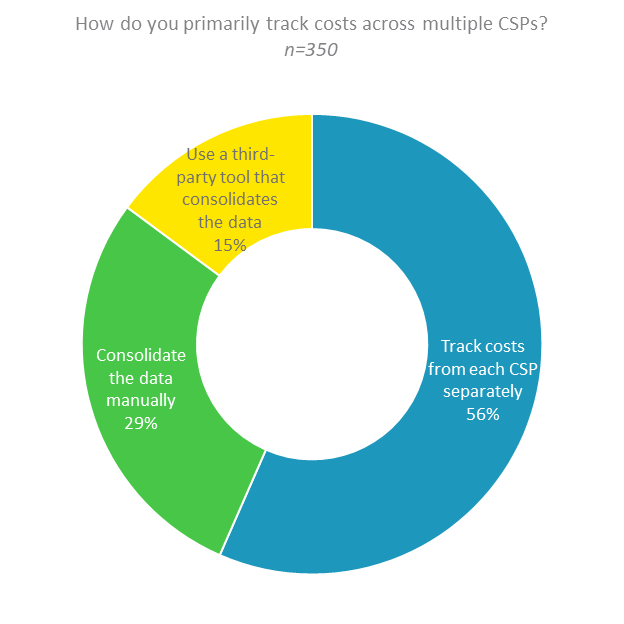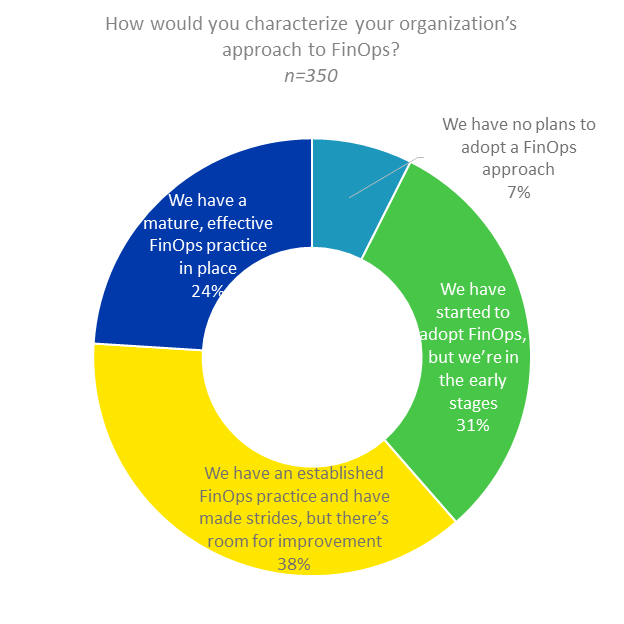Most companies overspend on cloud services. Many factors contribute to this problem, and while organizations know that their cloud budgets are bloated, they still struggle to reel in those costs. Are they implementing the tools and processes to track their cloud costs effectively? And are they adopting controls to instill discipline and accountability in their cloud spending habits? We explored these questions in our latest State of Multi-Cloud Management research report.
Enterprises are concerned about cloud costs
Controlling cloud spend is an issue that enterprises are concerned about. We asked about top challenges in managing hybrid/multi-cloud infrastructures, four of which are cost-related, including the top two issues cited. In fact, “keeping rising costs under control” was the number-two challenge, cited by 44% of respondents.

Every organization knows at a high level what it spends on the cloud—the monthly bills give you that top-line information as well as some additional breakdowns. But for most enterprises, this is insufficient. In fact, 73% of survey respondents said it’s important or very important to understand their cloud costs at a detailed level. And while 57% say they know exactly who is responsible for all of their cloud charges, that’s a significantly smaller group, indicating that enterprises don’t have all the cloud cost details they need to control their spend.

Organizations struggle to answer key cloud cost questions
Two-thirds of organizations track their cloud costs on a weekly or monthly basis. They’re fairly evenly split, with 33% reviewing those costs weekly while 34% do so monthly.

You might think organizations that need to understand their cloud costs in greater detail would track those costs more frequently, but this is not the case. In fact, respondents who said it’s not important to understand cloud costs at a detailed level are far more likely to track those costs daily—29% vs. 16%.

It’s also essential to understand who within the organization is tracking these costs. IT is carrying the cloud cost-tracking burden. While 89% of respondent organizations involve IT in the process, only 41% include finance/procurement. Given the size and variable nature of cloud spend, this is surprising.

The final question—in addition to who and when—is how organizations track their cloud costs. Most—76%—are using their monthly cloud bills. This is a good start, but as noted above, it is insufficient, especially if you want to understand your cloud costs in detail. The next most prevalent method, used by 57% of respondents, is to upload cost data spreadsheets to BI tools. This will undoubtedly give them the ability to analyze cloud cost data in various ways, but it can be a time-consuming effort.

There’s also the question of how to track costs across multiple CSPs. Multi-cloud is a reality for 83% of respondents, so this is a near-universal concern, but most organizations don’t have an efficient response. Almost one-third (29%) are consolidating the data manually, which may give them a full multi-cloud view into their costs, but it requires time and effort to get there. And more than half (56%) are simply tracking costs from each CSP separately, which makes it difficult to get a holistic view of cloud costs across the enterprise.

Given the variable nature of cloud costs, another important how question is: How do you find out about cost-impacting changes in utilization? The good news is that two-thirds of respondents (64%) get real-time alerts based on specified thresholds, which means they can act fast to prevent the accumulation of hefty charges.

While many of these approaches are highly reactive, that’s not necessarily a problem if they are simply one tool in a well-stocked cloud cost management toolbox. However, about one-third of respondents cited a single method employed to find utilization changes that affect cloud spend. And of this group, only 39% are using real-time alerts. This means that 61% of organizations in this cohort rely exclusively on just one after-the-fact method to learn about cost-impacting changes—and at that point, they may have racked up high costs that could have been avoided or at least contained.

Financial accountability structures are underdeveloped
FinOps is the practice of bringing financial accountability to the variable spend model of the cloud to enable all teams to make informed and appropriate business trade-offs between speed, cost, and quality. Less than one-quarter of respondents (24%) have a mature, effective FinOps practice in place, leaving 76% with incomplete, or even nonexistent, processes and controls to hold stakeholders throughout the organization accountable for cloud costs.

Does insufficient cost tracking hinder accountability? Or does a lack of accountability reduce the pressure to track costs in detail? The answer to this chicken-or-egg question almost doesn’t matter. The truth is, enterprises that want to control their cloud spend need both cloud cost tracking and cloud spend accountability.
Virtana enables detailed cloud cost tracking and accountability
Virtana Cloud Cost Management, part of the Virtana Platform, helps you demystify your cloud costs, enabling you to confidently manage your cloud expense to avoid end-of-month surprises. Real-time data collection and analytics allow you to analyze data easily across your hybrid cloud environments, even as conditions and options change. With deep insight into your spend across cloud providers and the ability to quickly customize reports to meet different functions’ and business units’ needs, you can keep all your stakeholders informed and accountable. Try Virtana Cloud Cost Management for yourself
Get the survey report: The State of Multi-Cloud Management
Control your cloud spend: Try Virtana Cloud Cost Management for free

David McNerney
Product Manager, Virtana




